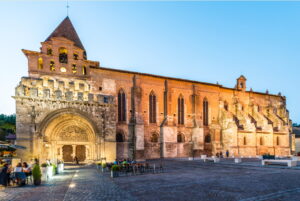MOISSAC, A MEDIEVAL GEM IN L’OCCITANIE
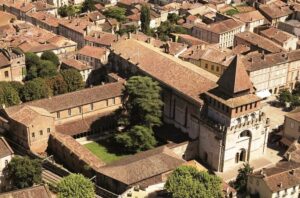
An hour’s drive north of Toulouse lies the medieval town of Moissac at the confluence of the Garonne and Tarn rivers, at the Canal de Garonne. We had been to Moissac a few years ago, drawn by the town’s medieval Abbey. It was classified as a UNESCO World Heritage Site in 1998 as a landmark church on the pilgrimage route to Santiago de Compostela. Renowned for its magnificent sculptures, and especially for its beautiful cloister, the Abbey is one of the country’s jewels of Romanesque art. To add to its attractions for the visitor, Moissac also has one of the highest concentrations of Art Déco buildings in South West France. It was an obvious choice for an overnight stopover as we headed towards Bordeaux from the Languedoc.

Moissac’s position right on the banks of the river Tarn, with the Garonne close by, makes it a very pleasant stop-off for night or two. The river is constantly active, with commercial and private craft negotiating it, as well as people rowing and kayaking. The river bank on the town side has been landscaped for a considerable length, with trees, plants and picnic tables, well used by locals and visitors alike, and has become the favourite spot for morning and evening dog-walking. Between the Napoleon bridge and the former Moissac mill that’s now a hotel, it’s the perfect location for an evening stroll.

The main reason to visit Moissac is certainly the Abbaye Saint-Pierre, one of the most famous and revered sites in the whole of France. Making your way along the Place Roger Delthil, past tempting cafes, ice-cream shops, cafes and restaurants, at the end of the road you will see the abbey. It’s only as you get closer that you realise that you are indeed standing in front of a masterpiece of medieval architecture, whose porch is one of the most powerful and beautiful works of the Middle Ages.
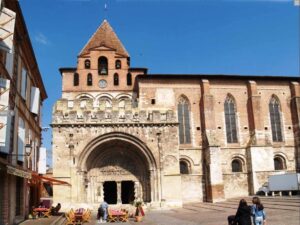
There is a legend that says the first Benedictine monastery was founded here by Clovis in 506 AD to commemorate his victory over the Visigoths. The battle had cost him over 1,000 men, whom Clovis declared would be remembered by an abbey of 1,000 monks. Legend has it that Clovis climbed a hill and hurled his trusty javelin, asking God to guide it where He saw fit. The javelin landed in a swampy marsh, and Clovis, never questioning the Almighty’s odd choice, ordered that an abbey be constructed on that spot. It’s not known if the story has even a grain of truth in it, or if the monks concocted the story in order to explain their ongoing problems with rising damp!
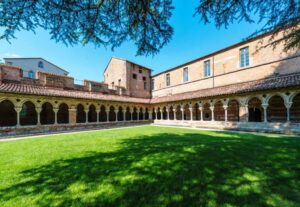
An alternative, and more plausible, story asserts that the monastery was established by the Bishop of Cahors in the 7th century. The establishment of the monastery was difficult because of raids by Moors from the south and west, and Norsemen from the north. The abbey was sacked by the Arabs of Al-Andalus twice around 732, was looted in the 9th century by Norman pirates, and in the 10th century by Hungarians. In 1030 the roof collapsed from lack of maintenance, and in 1042 there was a serious fire. In 1047, the Bishop of Toulouse appointed the abbot of Cluny, Odilon de Mercoeur, to bring in sweeping reforms to bring to a halt the laxity of the monks. A new building was added in 1063, along with significant restoration works to what was left of the original. The new building was consecrated by Pope Urban II, and in 1097, 40 churches were returned to the control of the abbey, and he also ordered the construction of the cloister, which was completed in 1100.
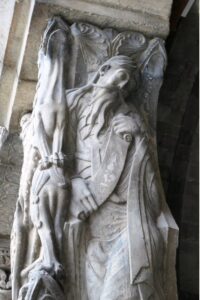
The depiction of the Apocalypse of St John, from the Book of Revelation, on the tympanum of the abbey portal is superb. At its centre is an intricately carved trumeau (pillar), with a depiction of the prophet Isaiah, an outstanding example of Romanesque sculpture. The tympanum, originally vividly painted, rests on a lintel recycled from a Gallo-Roman building, is decorated with 8 large thistle flowers and enclosed in a twisting vine, spat out by a monster at one end, and swallowed by another monster at the other.
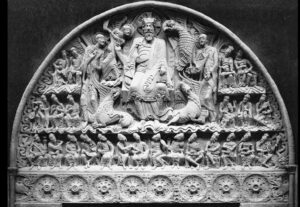
The main scene represents one of the key visions of the Apocalypse, of Christ sitting in the Judgement of Nations, with the Book of Life in His hand. The sides consist of illustrations of the life of the Virgin, the childhood of Jesus, the parables of Lazarus and the miser, as well as representations of the Deadly Sins.

To see the magnificent cloister behind the church, rather than accessing it from inside the church, you head out the front door again and around to the side. Visitors now enter the cloister via a new, impressive information foyer, which wasn’t there on our first visit a few years ago. There is a small fee of around 6.50 Euros to visit the cloister, although of course the church is free. Check the closing time of the cloister, and note that the last tickets are sold 20 mins. before the stated closing time.

The sublime cloister is regarded by many experts as the finest in the world. Quite a claim, but when you make your way slowly around it, admiring the 8 pillars, the 76 beautiful Romanesque capitals, reliefs and columns depicting saints’ lives, martyrs, and Biblical stories featuring foliage, animals and humans, all obviously sculpted by master craftsmen, you can understand its World Heritage status. The centre of the cloister is simply green grass with a tall fir tree in the middle, making it a perfect place for meditation and quiet contemplation.

The town of Moissac is more than its beautiful Abbey. In March 1930, the river Tarn flooded, destroying much of the town centre, and left thousands homeless. Reconstruction work began with a dozen architects from Toulouse, who, inspired by the architectural fashion of the time, brought geometric shapes, well-defined angles, bold cut-out openings, ironworks, frescoes and mosaics. We now call this style Art Deco. From the banks of the river Tarn to the Faubourg Sainte-Blanche in the centre of town, you will discover this exceptional and surprising architectural heritage of Moissac. Ask at the Tourist Office about the regular walking tours that cover a circuit of the Art Deco area, that take around 2 hrs., costing about 5 Euros.
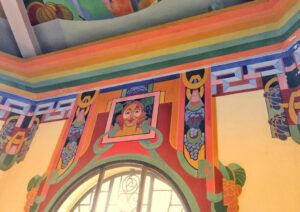
One of the other things Moissac is known for is a variety of white table grapes, called Chasselas. This juicy, delicious grape was the first fresh fruit to obtain, in 1971, a Denomination of Controlled Origin (AOC).
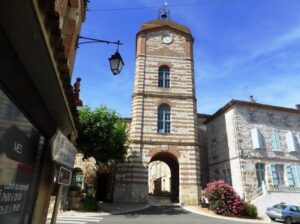
Moissac is a good centre from which to explore a couple of worthwhile interesting sites and small towns. One of the most interesting, and well worth a visit, is Auvillar, which lies about 21 kms to the west of Moissac, on the river Garonne. Auvillar has been designated one of the Plus Beaux Villages de France (Most Beautiful Villages of France). This picturesque town is also on the pilgrimage route to Santiago de Compostella.

Strolling through the village, you can admire its beautiful timber-framed houses that have been magnificently preserved or restored. Perhaps the village’s best-known landmark is its striking circular market hall, prominently placed in the centre of a triangular market square. The church has an imposing rose window and a most impressive bell tower, as well as a clock tower which is one of the gateways into the village.
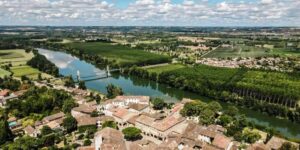
From the former castle square you can enjoy a panoramic view over the Garonne valley and surrounding villages. A former Ursuline convent now houses the Tourist Office, and its former chapel has been converted for use as the town’s main exhibition space. Take a pleasant walk along the river banks to the Port of Auvillar, which was the source of the village’s wealth, thanks to the barges that transported the famous Auvillar earthenware along the Garonne to Bordeaux.

Every year, the village is host to a hugely popular winegrowers’ festival, called the Saint-Noé (Noah). This is an opportunity for the locals to dress up in the most beautiful historically-inspired outfits, and participate in community singing, feasting and generally participating in rather unruly antics throughout the village! Auvillar was recently voted by the French people as the most popular village in the Occitane region.
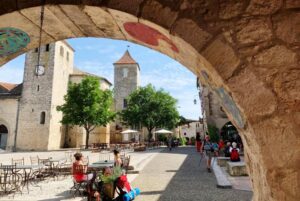
Another village designated since 1990 as a Plus Beaux Village is Lauzerte, which lies less than 20 kms to the north of Moissac. It too is on the pilgrimage route to Santiago de Compostella. Perched on a hill, it was a Gallic oppidum (fortified town) more than 2,000 years ago. At the end of the 12th century, the Count of Toulouse built a fortified castle, taking advantage of the town’s hilltop position. Lauzerte is said to be the earliest version of the bastide, or fortified town. The medieval ramparts are still intact, enclosing the village, together with towers and six portes (gates), that historically controlled the entrance into the village.

The village is highly regarded for the quality of its medieval architecture, most of which is grouped around the church of St Barthélemy. The arcaded main square in the centre of the village has several cafes and bars to choose from. As you arrive in the heart of the village, pop into the Tourist Office and ask for the map ‘Lauzerte, Itinéraire d’une Bastide’. There is also a well planned ‘Pilgrims’ Garden’ on the southern edge of the village that follows around the curve of the hill and has won various awards from regional tourist boards, and from where you can enjoy extensive views to the south across the countryside.

Lauzerte is in the heart of the Chasselas wine region as well as the Quercy melon-growing district. In the autumn the whole hillside glows with the colours of fruit trees, sunflowers, grapevines and lavender. There are many resident artists in Lauzerte who exhibit and sell their works in the village galleries. In the summer there are all kinds of exhibitions, an antiques market, a flower festival in April, a farmers’ market every Saturday and a “Marché Gourmand” every Thursday evening in July and August.

Moissac is very accessible. It is on the regional train line between Bordeaux, Agen, Montauban and Toulouse—it takes around 2 1/2hrs. from Bordeaux. By car, it’s 186 kms S.E. of Bordeaux, and about 73 kms north of Toulouse.
